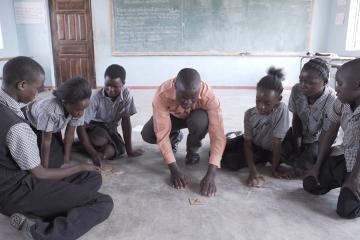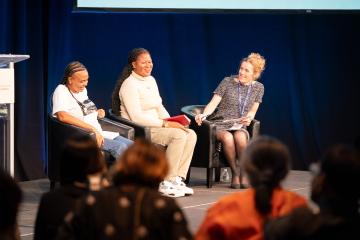
The Evidence Effect: Ideas for the future of development

I’ve worked on improving the effectiveness of social programs and policies with evidence for over fifteen years at J-PAL. Several things are clear: Fewer people today are living in extreme poverty, science and data have made a difference, and development spending can improve people’s lives in vitally important, measurable ways. But massive challenges remain.
Despite record-breaking economic growth and concerted development efforts worldwide, almost 700 million people—twice the entire population of the United States—still live on less than $2.15 per day. Many don’t have access to clean water, basic health care, or stable employment, and struggle to feed their families.
In the last few months the US government has dramatically cut foreign assistance, raised existential questions about its purpose, and promoted skepticism about what it achieves. Other governments and philanthropies are making decisions that will shape the future of development, and it is evident that more major changes are underway.
An important part of our mission at J-PAL is to bring evidence on what works in development to the forefront of debates to help shape better policy. In our new Evidence Effect web page and blog series, we will share what we have learned about improving the lives and livelihoods of people who are experiencing poverty, near conflict, or affected by a volatile climate. We’ll discuss how these lessons have changed thinking, investments, and outcomes that matter—like people living longer and healthier lives, escaping extreme poverty, and gaining better economic opportunities. Our hope is that these ideas can contribute to the conversation on the future of development.
Reconsidering the impacts of development spending
Though spending on global health and development is less than one percent of GDP in most high-income countries, many people in those countries massively overestimate how much goes to aid and are supportive of cuts. Some believe there is significant waste, inefficiency, or outright fraud in disbursement of aid, and that the costs outweigh the benefits. This scrutiny raises an important question: What really are the impacts of development spending?
J-PAL was founded in part to answer this question. As an objective, non-partisan, independent research center, we use rigorous field experiments to understand which programs are effective, which are not, and why, based on high-quality data and evidence. With this knowledge, we partner with governments and funders to increase their value for money and return on investments. We are deeply committed to the rigor, accuracy, and independence of our work—and we think this perspective is especially useful today.
Whether you are a funder, policymaker, advocate, implementer, researcher, or corporate leader, we hope this series provides practical guidance on how to approach investing in impactful programs.
Our first batch of examples shows that development spending can save lives and help people lift themselves out of extreme poverty
Over the past two decades, researchers in the J-PAL network have rigorously evaluated more than 1,500 development and social policy programs in more than 90 countries. Partners have ranged from small, passionate NGOs to large government agencies and the private sector.
The good news, and the theme of this first installment of The Evidence Effect blog series and examples, is that development spending can work—many of the programs that have been evaluated are effective, some remarkably so. Many have scaled to reach more people: By a conservative count, at least 850 million people have been reached by the scale-up of programs evaluated by J-PAL researchers alone. And still others could be scaled even more.
These six examples highlight programs with credible evidence of saving lives, reducing the burden of preventable diseases, and helping the world’s poorest transition out of extreme poverty:
Giving low-cost preventive health products for free makes it more likely people will use them; some of these programs have scaled to reach hundreds of millions of people. Novel approaches that encourage parents to vaccinate their children, and that share information with teens about HIV, can change decisions in ways that keep kids and teens safer and healthier. Once a child has reached school age, investing in girls’ scholarships achieves more than just better education—it can save the lives of their children years later. Holistic programs like the Graduation approach can sustainably transition families out of extreme poverty, and unconditional cash transfers help households improve their food security and overall well-being.
Learn more about these programs, how foreign assistance and philanthropy played critical roles in their success, and how governments and others are scaling some of these approaches on our Evidence Effect page.
Using data and evidence to guide future decisions
The growing evidence base has put us in a vastly better place to fight poverty than we were two decades ago, and can help governments and donors chart a path forward for more effective development spending. Each upcoming post in The Evidence Effect blog series will feature insights from J-PAL’s work, a related reflection for the future of development, and several examples of evidence-informed programs that illustrate those ideas. Future posts will argue:
Part 2: Funding and scaling decisions should be driven more by evidence of impact and cost-effectiveness. John Floretta and Claire Walsh will discuss how to do more with less by using impact evidence and cost data to make prudent choices, and how this principle should underpin development spending by country governments and donors, especially when resources are scarce.
Part 3: Low- and middle-income country (LMIC) governments should continue to play a pivotal role in driving poverty reduction. Most LMIC governments spend far more on their own social programs than foreign donors, and should continue to drive their own development agendas. Lina Marliani and Paula Pedro will share examples of governments scaling effective approaches and ideas for how to advance government innovation.
Part 4: Strengthening government capacity is key to improving outcomes in the long term and reducing the need for foreign assistance. Bolstering LMIC governments’ abilities to fund, manage, and deliver public services can help ensure that health, education, and infrastructure reach people in need. Tithee Mukhopadhyay will share more.
Part 5: Foreign aid and philanthropy are important catalysts for development innovation and scale. Bilateral aid agencies, philanthropy, and multilaterals can complement the role of LMIC governments, serving as catalysts for advancing effective development by supporting learning, taking calculated risks, and helping diffuse new innovations. Alison Fahey will elaborate.
Part 6: A vibrant private sector is key to sustainable development and reducing the need for foreign assistance. Strengthening the private sector to create more jobs and promote innovation and investment leads to increased opportunity and higher incomes. Julie Cobill and Ahmed Elsayed will share more on what we’ve learned to support these goals.
Part 7: Evidence can improve the effectiveness of humanitarian programming. While there is consensus that humanitarian aid is essential to addressing urgent crises, Cillian Nolan will write about how bringing an evidence lens to this programming can help ensure limited resources reach the most vulnerable, and maximize impacts.
Part 8: Social policies in high-income countries should also benefit from evidence-informed policymaking. Much of the same scrutiny now directed at development spending is also focused on social spending in wealthier countries. Laura Feeney, Cillian Nolan, and Vincent Quan will share promising, rigorously evaluated ideas from Europe and the United States, including some that have successfully scaled.
With fewer resources available, the bar is even higher for deciding which social sector and development programs to invest in. Evidence can help governments, funders, and implementing organizations navigate today’s challenges and make more effective and cost-effective decisions. As The Evidence Effect continues, please reach out and let us know what you think. My colleagues around the world are ready to help.


